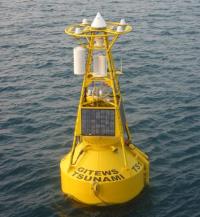 After the devastating 2004 Indian Ocean tsunami that killed nearly a quarter of a million people, the United States, Germany, and Malaysia donated an advanced tsunami warning system to Indonesia. When the city of Palu on the island of Sulawesi, Indonesia was hit by tsunami waves of up to 6 meters following the magnitude 7.5 earthquake on Friday, none of the 22 tsunami early warning buoys was working. Some have been damaged by vandals and others have been stolen. Reportedly, the system has not worked for at least the last six years due to a lack of funding.
After the devastating 2004 Indian Ocean tsunami that killed nearly a quarter of a million people, the United States, Germany, and Malaysia donated an advanced tsunami warning system to Indonesia. When the city of Palu on the island of Sulawesi, Indonesia was hit by tsunami waves of up to 6 meters following the magnitude 7.5 earthquake on Friday, none of the 22 tsunami early warning buoys was working. Some have been damaged by vandals and others have been stolen. Reportedly, the system has not worked for at least the last six years due to a lack of funding.
Indonesia does have a tsunami early warning system, but it is limited in its capabilities. The nearest closest tsunami tidal gauge to Palu was over 200km away. Based data from this gauge the Indonesian authorities predicted a tsunami wave of from 0.5 to 3 meters high.
BBC reports, Indonesia’s tsunami early warning system is currently made up of a network of 170 seismic broadband stations, 238 accelerometer stations, and 137 tidal gauges.
But according to BMKG’s head of earthquake and tsunami center, the current system in place is “very limited”.
“Our [current] tools are very lacking,” said Rahmat Triyono, speaking to BBC Indonesian.
“In fact, of the 170 earthquake sensors we have, we only have a maintenance budget for 70 sensors.”
However we do know that the system did, in fact, pick up the tsunami – because a warning was sent out – but what it failed to do was accurately gauge the scale of the tsunami.
The number of people known to have died in Indonesia in Friday’s earthquake and tsunami has risen to 1,347.

Oregon State University’s Chris Goldfinger points out that these buoys are worthless for near-field tsunami warning. If they had been working, it wouldn’t have mattered. Responding to news this buoy system would have saved many lives, Dr. Goldfinger responded on Facebook’s Pacific Northwest Earthquake Discussion Group:
“This is dead wrong. This has been a long-term issue of miseducation. The tsunami warning systems are ineffective for the locals in a near field event. In Japan when I was there, they were effective for places that had longer travel times along the coast and up rivers, but the most proximal areas will never be served by them. The earthquake is the only effective warning, and education is key. In the US, the DART system was heavily oversold to Congress , and that legacy today means the we continue to pour money into the DART system while the states education programs languish. These warning systems cannot help in a local earthquake, whether in Indonesia, or anywhere else.”
If you are on a beach on experience a large earthquake, run, do not walk, to higher ground. If you wait for a warning, you will probably die.
btw, great blog! As a former USNR Engineering Duty Officer, I find the content very interesting!
You have only to look at the topography of the bay with Palu at its head to realise that it is a tsunami magnet in an area rather prone to earthquakes. Is this the first such incident there?
Will they rebuild the city… of course they will. It will never happen again they will say.
Should they be given more warning buoys? Hmm, what do you think?
Once Again The Main Stream media is wasting our time:
Indonesia rocked by powerful quake, tsunami warning called off!!!
https://www.france24.com/en/20180928-indonesia-rocked-powerful-quake-tsunami-warning-called-off
An Indonesian friend of mine tipped me off to this Giant Boo-boo